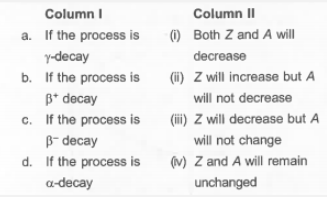What kind of change takes place in a nucleus when a γ-particle is emitted ? Express it by an equation. State whether (a) atomic number, and (b) mass number are conserved in a radioactive γ-decay ?
To solve the question regarding the changes in a nucleus when a gamma particle is emitted, we can follow these steps:
1. Understanding Gamma Emission:
- A gamma particle is a high-energy photon emitted from a nucleus during radioactive decay. Unlike alpha or beta decay, gamma decay does not change the number of protons or neutrons in the nucleus.
2. Equation Representation:
- When a nucleus emits a gamma particle, it can be represented as:
AZX→AZX+γ
- Here, AZX represents the parent nucleus, Z is the atomic number, A is the mass number, and γ represents the emitted gamma photon.
3. Conservation of Atomic Number and Mass Number:
- In gamma decay, since there is no change in the composition of the nucleus (no protons or neutrons are lost or gained), the atomic number (Z) and mass number (A) remain the same.
- Therefore, we can conclude:
- (a) Atomic number is conserved: Yes, it remains the same.
- (b) Mass number is conserved: Yes, it remains the same.
Final Equation Example:
To illustrate with an example, consider the decay of Uranium-238:
23892U→23892U+γ
This shows that Uranium-238 emits a gamma particle without changing its atomic or mass number.
Summary:
- Change in nucleus: No change occurs; only energy is emitted.
- Conservation: Both atomic number and mass number are conserved in gamma decay.
- A gamma particle is a high-energy photon emitted from a nucleus during radioactive decay. Unlike alpha or beta decay, gamma decay does not change the number of protons or neutrons in the nucleus.
- When a nucleus emits a gamma particle, it can be represented as:
AZX→AZX+γ
- Here, AZX represents the parent nucleus, Z is the atomic number, A is the mass number, and γ represents the emitted gamma photon.
- In gamma decay, since there is no change in the composition of the nucleus (no protons or neutrons are lost or gained), the atomic number (Z) and mass number (A) remain the same.
- Therefore, we can conclude:
- (a) Atomic number is conserved: Yes, it remains the same.
- (b) Mass number is conserved: Yes, it remains the same.
To illustrate with an example, consider the decay of Uranium-238:
23892U→23892U+γ
This shows that Uranium-238 emits a gamma particle without changing its atomic or mass number.
- Change in nucleus: No change occurs; only energy is emitted.
- Conservation: Both atomic number and mass number are conserved in gamma decay.
Topper's Solved these Questions
- RADIOACTIVITYBOOK - ICSECHAPTER - RADIOACTIVITYEXERCISE - MULTIPLE CHOICE TYPE
6 Videos
- RADIOACTIVITYBOOK - ICSECHAPTER - RADIOACTIVITYEXERCISE - EXERCISE-12(B)
19 Videos
- RADIOACTIVITYBOOK - ICSECHAPTER - RADIOACTIVITYEXERCISE - NUMERICALS
2 Videos
- QUESTION PAPER-2019BOOK - ICSECHAPTER - QUESTION PAPER-2019EXERCISE - SECTION-II
42 Videos
- REFRACTION OF LIGHTBOOK - ICSECHAPTER - REFRACTION OF LIGHTEXERCISE - DIAGRAM BASED MCQ:
5 Videos
Similar Questions
The atomic number and the mass number of an atom remains unchanged when it emits
View SolutionMatch the column in radioactive decay process of nucleus with atomic number Z and mass number A.

View SolutionA uranium nucleus .92U238 emits and α-particle and a β-particle in succession. The atomic number and mass number of the final nucleus will be
View SolutionA nucleus Pu emits an alpha particle and changes to U which emits a beta particle and then a gamma particle to change into 23593Np. Write the above nuclear changes in form of an equation stating the atomic number and mass number of each nucleus.
View SolutionState the relation between atomic number and atomic mass for light elements. State which elements are considered radioactive giving reasons.
View SolutionWhat are the respective number of α and β-particles emitted in the following radioactive decay?
View SolutionIn a radioactive decay, neither the atomic number nor the mass number changes. Which of the following particles is emitted in the decay?
View SolutionWhat happens to the mass number and atomic number of an element when it emits gamma- radiation
View SolutionShow by equations, the effect on the proton number Z and mass number A of the parent nucleus brought about by the two types of radioactive decay.
View SolutionA nucleus .AZX emits an α-particel. The resultant nucleus emits a β+ particle. The respective atomic and mass numbers of the final nucleus will be
View Solution
